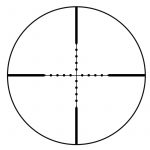In short summary of the post Minute of Angle (MOA) for Scope Adjustment, a minute of angle is 1/60th of a degree, and there are 360 degrees in a circle. If the target is at the edge of a giant circle and you are at the center, then you can calculate the width of a minute of angle, which conveniently is about one inch at 100 yards (rounded from 1.047 inches).
The rounding error becomes more significant with increased range to the target; for example, one minute is about 10.5 inches wide at 1000 yards, and about 21 inches at 2000 yards. The width of the angle increases linearly with distance—double the distance to the target, and the width of the arc will also double at that distance. Describe that width using whatever units make sense to you.
A radian is another measure of angle, also based on a circle but in a slightly different way—that doesn’t need to be calculated using π, or trigonometry, or any other textbook math equations.
OK, there may be some geometry involved, but this is simple. Think of the same circle with the target on the circle’s edge and you in the center. The radius is the distance from you to the target; say 100 yards.
To measure a radian, go to the target and pace around the circumference of the imaginary circle. Stake your starting point, walk 100 yards, and stake your ending point. The arc of circumference between the two stakes measures 100 yards—the same distance as the circle’s radius.
Now go back to the center of the circle, and draw two imaginary lines, each ending with a stake. The arc of the circle is 100 yards wide. The angle between the imaginary lines is one radian.
Therefore a radian is the angle you would get if the arc of the circle was the distance of one radius. For a 100 yard range, a radian is 100 yards wide—like the degree, too big to be practical.
So for shooting, we divide the radian into 1000 slices, called the Milliradian, or Mil. Mil doesn’t stand for military—the prefix “milli-” means 1/1000th in metric lingo, like there are 1000 millimeters in a meter. Also, don’t confuse the prefix milli- with the word million, as in dollars. The Mil is 1/1000th of a radian.
One Mil just means 1/1000th. It’s exactly 10 centimeters at 100 meters, or it’s exactly one meter at 1000 meters. Beautiful, isn’t it?
In Imperial units, a Mil is one yard (36 inches) at 1000 yards, or 3.6 inches at 100 yards. The math is no more complicated than this—the Mil is 1/1000th of the distance to target. One yard at 1000 yards, or 1/10th of a yard at 100 yards. One meter at 1000 meters, or 1/10th of a meter at 100 meters.
Most Mil scope turrets adjust in 0.1 Mil increments—therefore one click of the turret moves your point of aim one centimeter at 100 meters, or 0.36 inches at 100 yards. My recommendation is to stay in one unit. You can mix and match—for comparison 0.1 Mil is 0.39 inches at 100 meters, or 0.9 cm at 100 yards—but converting back and forth will make your head hurt.
At the 2007 World Benchrest (group) Championships in Hölles, Austria, the ranges were in meters and the targets were scored in mm. Those of us from across the pond sought to calibrate our heads around the group sizes in metric at 100 meters, compared with our accustomed thousandths of an inch (thou) at 100 yards. The distance gap from 100 yards to 100 meters is significant for short range benchrest where battles are won and lost in thou—whereas one minute is 1.047 inches at 100 yards, it measures 1.145 inches at 100 meters.
Someone gave me a conversion hack so I could make sense of the numbers, but I remember being distracted by the math and tossed it aside, so I could focus solely on my shooting—and finished 13th (of 176 competitors) in the 2-Gun Grand Aggregate, at the top of the page with my husband George who finished 8th.
That’s not to say understanding the math isn’t important. Just remember that making your head implode by calculation overload isn’t helpful to your shooting mindset.

Holding for wind using the Mil-Dot scope is similar to holding using a scope having graduations in MOA.
